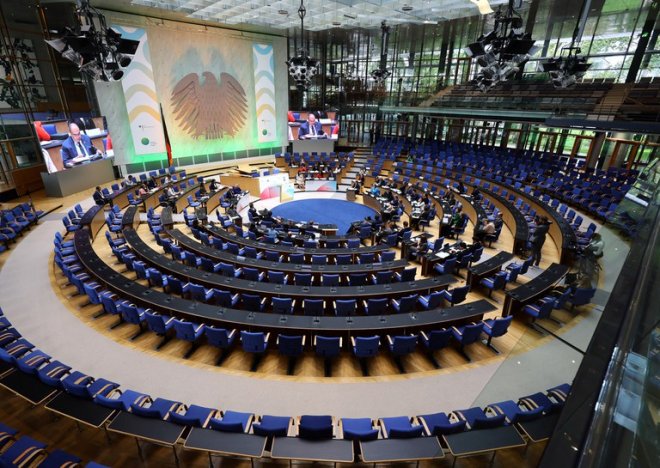North Korea demolishes old houses to build new ones, decreasing housing supply
The North Korean propaganda machine in recent years has been churning out image after image of rural citizens weeping with joy as they move into sleek new modern homes built for them by the state and handed over free of charge thanks to leader Kim Jong Un’s love for his people.The homes are said to be part of the government’s efforts to modernize the countryside, provide relief to people rendered homeless by natural disasters, or to add inventory to a dwindling housing supply.
A report broadcast on North Korean television in Sept. 2020 shows several residents of Kangbuk village in North Hwanghae province"s Kumchon county, said to be flood victims, weeping and giving thanks to Kim as the whole town celebrates completion of their new homes.
But the move-in-day tears and trembling voices caught on camera seem almost rehearsed, possibly indicating that there is more than meets the eye to the government"s construction efforts.
Satellite imagery reveals that in many cases, the new homes are built on top of where old homes once sat, suggesting that the government is knocking down existing homes to build new ones. Since the modern homes are larger than the ones they are replacing, the cumulative effect is that “Kim Jong Un’s love” is actually decreasing the supply of homes.
This is corroborated by stories of escapees from the North and experts who have analyzed before-and-after satellite photos.
News that an area has been designated to receive new houses makes residents unhappy and anxious because they could lose their existing homes or their vegetable gardens, said escapee Kim Gumhyok, who is now a current affairs commentator in the South.

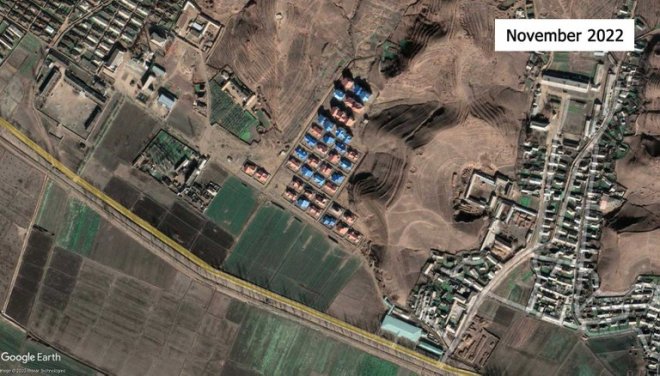
In the Jikjol neighborhood of Tanchon city, South Hamgyong province, about 100 existing houses were demolished and new-style duplex houses were built. Credit: Google Earth- Sooyoung Park, Taeyi Kim“The biggest reason why rural areas are very reluctant to accept reconstruction is that North Korea has no private farming,” Kim said. “Since most residents belong to cooperative farms, they don’t have ownership of agricultural products. But they can have their own vegetable garden.”
Demolishing 100 houses to build 60
The state-run Rodong Sinmun newspaper on Dec. 27 reported on completed construction of new homes in eight rural areas.
Jacob Bogle, who is curator of the AccessDPRK website which analyzes North Korea through satellite imagery, identified six of these areas using Google Earth. Only one of the six, located in the town of Oyu in the northeastern city of Chongjin was actually constructed on newly broken ground.
Bogle found that in the town of Naejung, North Pyongan province, builders first demolished 100 single-story houses to build 60 new ones, and in Jikjol, South Hamgyong province, 100 homes were knocked down to build 36 duplexes.
These are clear examples of the North Korean authorities exaggerating their achievements, he told Radio Free Asia’s Korean Service.
“[If] Kim Jong Un is promoting North Korea as a strong and powerful country, and the leadership is supposed to take care of the people, then, you need to have evidence of that even if it"s just a few houses in the countryside,” Bogle said.
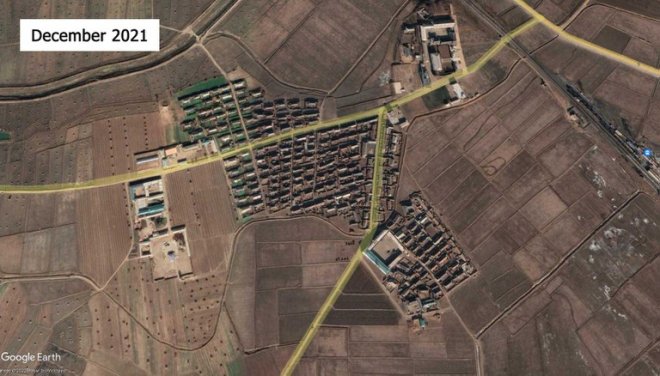
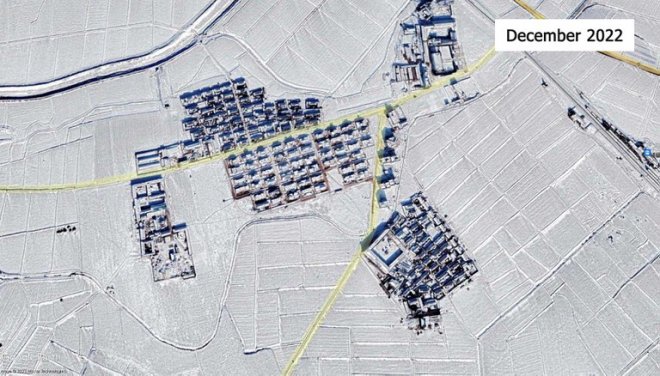
In Naejung town of Yomju County, North Pyongan province, about 100 existing houses have been demolished and new duplex houses have been built. In the image taken in December 2022, buildings are covered in a white blanket of snow. Credit: Google Earth- Sooyoung Park, Taeyi Kim.The so-called new homes are not enough to significantly increase the housing supply to the point that there are enough homes for everyone, said Choi Daesik, director of the North Korean Studies Center at the Daejeon, South Korea-based Land Housing Research Institute, or LHRI.
“But more important ... is that the number of houses that are equipped for modern living is low,” he said. “I think if you include all the old houses, probably only 80% are.”
Rural anxiety
North Korean media trumpets the creation of these new homes in its typically florid language.
“A new aspect of our rural civilization has opened in farm villages around the country,” a recent state-media news broadcast said. “This is bringing excitement and joy for a bright tomorrow to our people who are vigorously advancing toward all-around development in socialist construction under the leadership of the great party.”
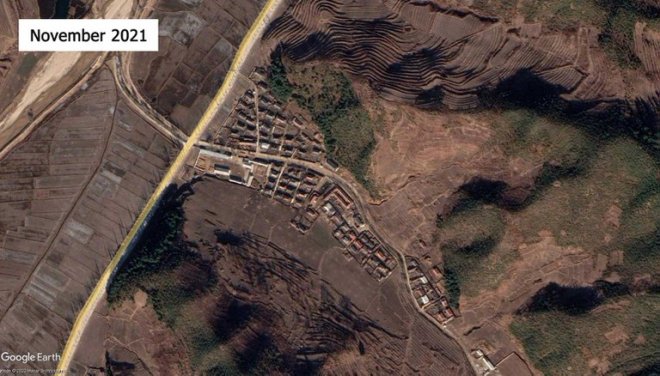
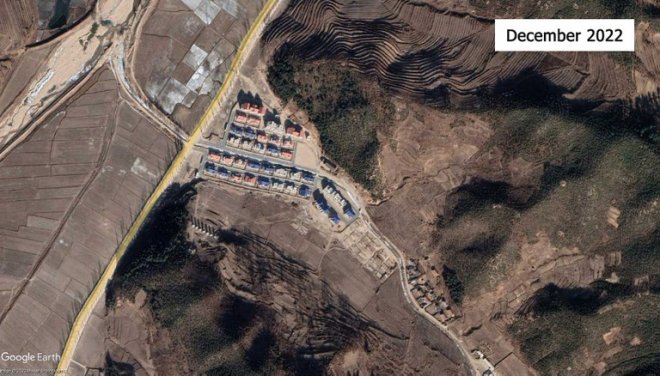
In Mundong village, Pukchong county, South Hamgyong province, about 60 existing houses were demolished and new duplex houses were built. North Korean refugees said that reconstruction has led to the disappearance of vegetable gardens, which were a legal source of income for rural residents. Moreover, ordinary residents are dissatisfied with the reconstruction because they often do not see the actual benefits of it. Credit: Google Earth- Sooyoung Park, Taeyi KimBut for many residents, the prospect of losing the family garden is disastrous. In a country where monthly salaries from the government amount to 50 or 60 U.S. cents, not even enough to get through a single day, small vegetable gardens are actually some families’ only means for support.
“Most of the farmers’ incomes actually come from the veggies they grow in their gardens,” said Kim, the escapee. “If a new house built for more than one family is built over one where only a single family lived, the ownership of the garden becomes ambiguous.
Some of the residents who are set to receive new homes complain upon hearing the news, because their rights to the garden are not solidified first, he said.
The new houses should go to those whose homes are being built over, or to people who became homeless after floods or other disasters, said Cho Chung Hee, another escapee who now runs the Good Farmers research center in Suwon, South Korea.
“After that, if there are a few extra houses available, they are not given out [fairly]. The people in power or those close to them will get to move in.”
Forced modernization
Increasing housing rates is not the only reason for North Korea’s extensive housing construction projects. Many existing homes that were hastily built decades ago and are now falling apart, said Seo Jae Pyoung, chairman of the Association of the North Korean Defectors.
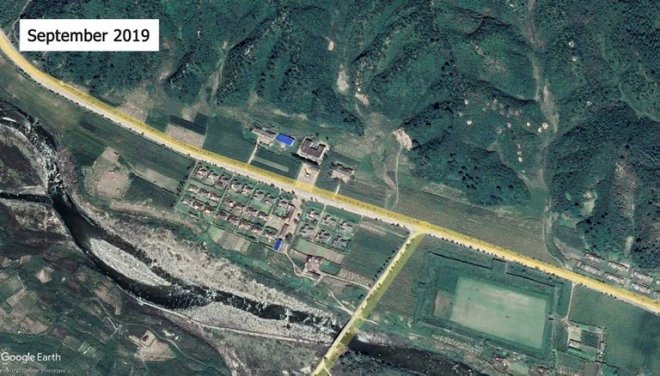
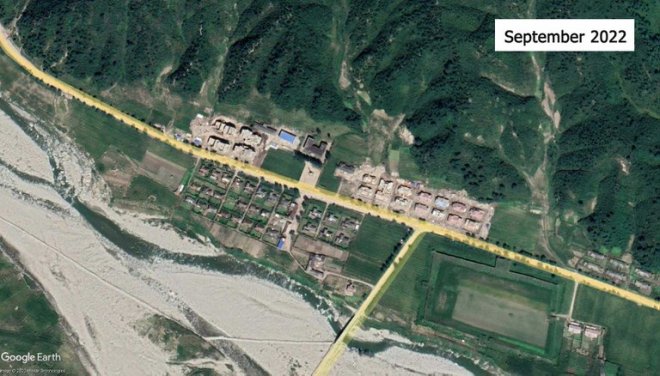
A new house has been built in a village in Oyu, Chongjin, North Hamgyong province. About 20 new-style houses are being built in the plains behind the existing houses. Credit: Google Earth- Sooyoung Park, Taeyi Kim“North Korea has a poor construction method, so the houses are very poorly built,” he said. “There is even a saying in North Korea that ‘Rural houses are easy to steal because they collapse after you pee a few times.’ In fact, after about 20 years, most houses will gradually crumble.”
Cho said that bad weather can ruin older homes.
“Although it differs from region to region, among the existing rural houses in North Korea, there are not many cement buildings, but many buildings built with soil," he said. “These houses collapse due to harsh weather conditions such as when the wind blows hard, or when heavy rains cause leaks. When natural disasters happen, rural houses suffer the most.”
Bogle said that the need to modernize North Korean homes became glaringly apparent a few years ago when North Korea experienced record amounts of daily rainfall, and was then hit by three typhoons in the same month.
“That caused a lot of damage, so they needed to replace that housing to begin with,” Bogle said. “Especially in the countryside, a lot of the houses are many decades old. A lot of them still don"t even have electricity, so these newer houses are needed.”
Choi said a major reason why houses have to be knocked down to build more houses is because North Korea lacks the capacity to build infrastructure.
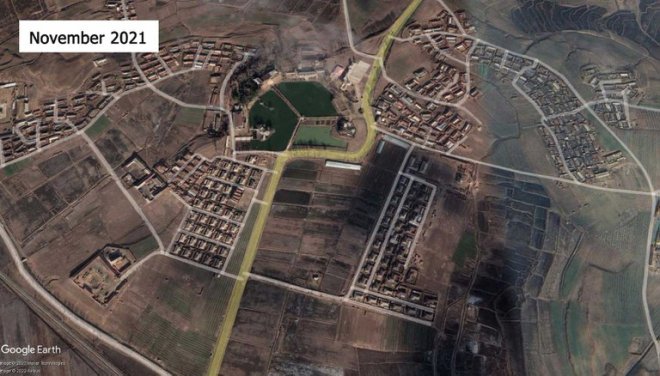
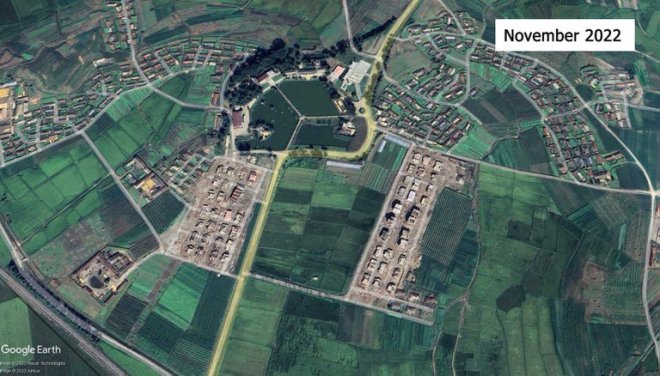
About 80 existing houses are being demolished and new houses are being built in the Sinchon neighborhood of Chongju, North Pyongan province. Credit: Google Earth- Sooyoung Park, Taeyi Kim“In reality, you cannot build just the house for a house to function as a dwelling. It is necessary to have infrastructure such as roads and water and sewage in it,” he said. “Existing houses already have a foundation in place. So, reconstruction can reduce the costs … compared with building everything new.”
Often, the party will order the rural areas to build new houses, but will not supply all the construction materials, leaving the burden on the local governments, Kim said.
“In some places, it is necessary to be self-sufficient,” he said. “I know there are many tricks for those places, such as tearing down and rebuilding an existing house or changing its use. In any case, the plan must be fulfilled.”
Cho said the North Korean government should focus on really building houses for the people rather than doing it to achieve economic benchmarks that the government can then turn into propaganda.
“In fact, in order to improve housing shortages and housing conditions in North Korean rural areas, I think they should invest and build proper houses,” he said.
RFA Korean would like to thank Bruce Songhak Chung, the deputy director of the Geo Satellite Information Research Institute and Kyungpook National University in South Korea, for assistance with this report.
Translated by Claire Shinyoung Oh Lee and Leejin J. Chung. Edited by Eugene Whong and Malcolm Foster.
[圖擷取自網路,如有疑問請私訊]
|
本篇 |
不想錯過? 請追蹤FB專頁! |
| 喜歡這篇嗎?快分享吧! |
相關文章
AsianNewsCast









